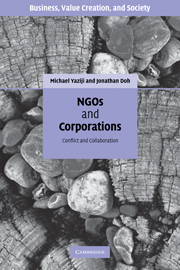Book contents
- Frontmatter
- Contents
- List of figures
- List of tables
- Preface
- Foreword
- Acknowledgments
- Part I Understanding NGOs
- Part II NGO advocacy campaigns
- 4 NGO campaigns against corporations and (de-)legitimacy
- 5 How do they do it? Understanding the power and influence of radical advocacy NGOs
- 6 NGO campaign types and company responses
- Case illustration: PETA and KFC
- Case illustration: Coca-Cola in India
- Part III Corporate–NGO engagement
- Part IV The future of corporate–NGO relations
- Index
- References
6 - NGO campaign types and company responses
Published online by Cambridge University Press: 13 January 2010
- Frontmatter
- Contents
- List of figures
- List of tables
- Preface
- Foreword
- Acknowledgments
- Part I Understanding NGOs
- Part II NGO advocacy campaigns
- 4 NGO campaigns against corporations and (de-)legitimacy
- 5 How do they do it? Understanding the power and influence of radical advocacy NGOs
- 6 NGO campaign types and company responses
- Case illustration: PETA and KFC
- Case illustration: Coca-Cola in India
- Part III Corporate–NGO engagement
- Part IV The future of corporate–NGO relations
- Index
- References
Summary
As indicated in the prior chapters, firms are increasingly facing campaigns by NGOs over a broad range of issues such as the environment, labor, human rights, consumer rights and animal rights. These campaigns are not all of a single kind; in fact, the campaigns come in two directly converse flavors. In this chapter we will differentiate between two very different types of campaigns – watchdog campaigns and proxy war campaigns (introduced in Chapter 1) – which need to be understood and responded to in very different ways.
As mentioned in Chapter 4, early neo-institutional theory focused on how organizations, in order to gain and maintain the legitimacy necessary to survive, conform to institutional demands in the form of norms and rules. While institutions are broad and often diffuse, institutional pressure must ultimately be brought to bear on organizations by other organizations that give expression to institutional norms. These “institutionally expressive” organizations might be governmental bodies, professional associations or nongovernmental watchdog or advocacy groups. In its most elementary structural form, a single institutionally expressive organization puts “institutional pressure” on a single organization. For example, a regulatory body may threaten to or actually fine a firm for failing to meet federal environmental guidelines.
In some cases, this pressure is applied blindly or “impersonally,” meaning without regard to differences in institutionally neutral attributes of the organization or characteristics that are deemed irrelevant to the salient institutional issue.
- Type
- Chapter
- Information
- NGOs and CorporationsConflict and Collaboration, pp. 93 - 111Publisher: Cambridge University PressPrint publication year: 2009



